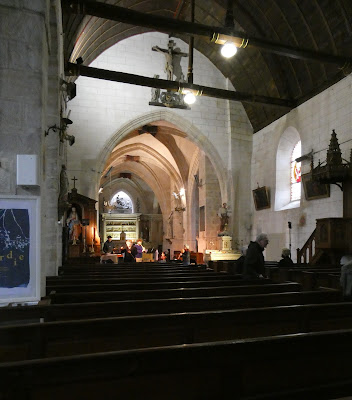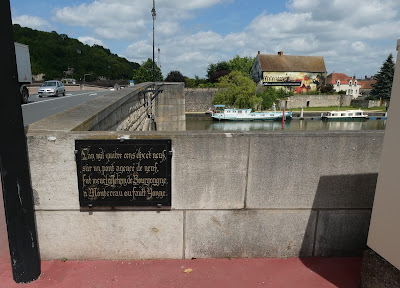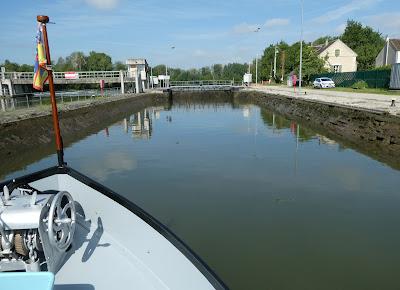Sens is still as lovely as ever. Last year's report of our stay in the town was full of photos of its beautiful old buildings and the contents of a fascinating museum. This year? Although we had two full days in town, the off-and-on rain and nearly constant cold temperatures kept us mostly around the boat. So many heavy coats on the pedestrians who dared to venture out for a stroll along the river! There were some breaks in the wet and a few peeks of sun, so I was able to accomplish the usual task of grocery shopping and Lon checked out the generator, and on Friday evening, May 31, we returned to an Italian restaurant on the main square that we ate at last year for a lovely dinner.
 |
| Italian seemed a better choice than this place. An unfortunate name, as my childhood concept of "icki" (icky) was of something disgusting or bad. |
I also managed to stroll through the local covered market on Saturday morning (June 1). It was the usual collection of meat-cheese-produce.
 |
| The stained-glass vegetables at the covered market looked awesome! |
 |
| Drooling is allowed when looking at the offerings at a French patisserie. Is it any wonder that I don't need the many baking utensils and pans that we inherited when we bought our boat? |
We'd hoped that by staying in Sens until Sunday, June 2, that the weather would improve. The Weather Channel kept promising that it would, but the day started out heavily grey, damp, and overall depressing before brightening somewhat in the evening. Still, we were ready to move on from Sens and started heading north again. The wind on the flybridge was biting, so our concession to the weather was moving to the indoor driving station. I, of course, would still have to deal with the outside during our passage through the day's locks.
We tried a new overnight stop between Sens and "the-end-of-the-Yonne" at Montereau. Instead of the pontoons at Pont-sur-Yonne after 2 hours of cruising, we continued for another hour before we moored adjacent to a "lovely" set of grain silos on a derivation canal. It was a bit rough as moorings go, but we hoped that the resultant shortening of the next cruising day would make it all worth it.
 |
| The "middle of nowhere" grain silos where we moored, as seen from the nearby village of Vinneuf. |
After a day of cruising, it's nice to get a walk in to stretch the legs. After checking out the first lock we'd be passing through the following day on our cruise to Montereau, we turned inland to the village of Vinneuf. It's old, but what in France isn't? The focal point of the village was the Church of Saint George, dating to the 13th and 16th centuries.
 |
 |
| The church interior had a wooden roof shaped like the hull of a boat. |
 |
| Recorders, and stringed instruments, and a forerunner of a bagpipe. |
It was too early in the day for us to hang around until the 5 p.m. concert, and it was still cold and windy, which made a warm boat much more enticing than the prospect of taking our bikes off the boat and returning to the church for the concert. A bit of a regret to be sure; we probably would have enjoyed the concert very much.
 |
| Vinneuf is in the middle of farm country. The wet spring has made everything very green. After the droughts of the past few years, nobody is complaining very much about the rain. |
 |
| Proof that aliens exist? The crops were flattened in parts of the fields we passed by, and we couldn't help but think that if we had a drone, we might see an amazing pattern in the field. |
 |
| Two vnf employees leave the "rear gate" (to us) control booth after fixing the issue that kept us a "captive audience" in the lock for 45 minutes. |
 |
| A great spot--right by the bridge that connects to the center of Montereau. |
 |
| A plaque commemorates Jean sans Peur 600 years after he was killed on an earlier version of the Montereau bridge. |
 |
| The battle as mural on the walls of a local building. The town conducted a huge re-enactment of the battle earlier this year in February to commemorate its 210th anniversary. |
 |
| Napoleon is still hanging around, in statue form at least, 210 years after the battle. |
 |
| The church has a prominent location overlooking the Yonne. |

No comments:
Post a Comment